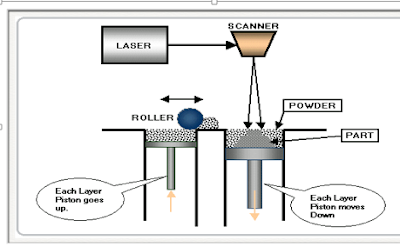Common to AM technologies is the use of a computer, 3D modeling software (Computer Aided Design or CAD), machine equipment and layering material. Once a CAD sketch is produced, the AM equipment reads in data from the CAD file and lays downs or adds successive layers of liquid, powder, sheet material or other, in a layer-upon-layer fashion to fabricate a 3D object.
The term AM encompasses many technologies including subsets like 3D Printing, Rapid Prototyping (RP), Direct Digital Manufacturing (DDM), layered manufacturing and additive fabrication.
AM application is limitless. Early use of AM in the form of Rapid Prototyping focused on preproduction visualization models. More recently, AM is being used to fabricate end-use products in aircraft, dental restorations, medical implants, automobiles, and even fashion products.
While the adding of layer-upon-layer approach is simple, there are many applications of AM technology with degrees of sophistication to meet diverse needs including:
+ a visualization tool in design
+ a means to create highly customized products for consumers and professionals alike
+ as industrial tooling
+ to produce small lots of production parts
+ one day….production of human organs
At MIT, where the technology was invented, projects abound supporting a range of forward-thinking applications from multi-structure concrete to machines that can build machines; while work at Contour Crafting supports structures for people to live and work in.
Some envision AM as a compliment to foundational subtractive manufacturing (removing material like drilling out material) and to lesser degree forming (like forging). Regardless, AM may offer consumers and professionals alike, the accessibility to create, customize and/or repair product, and in the process, redefine current production technology.
Whether simple or sophisticated, AM is indeed AMazing and best described in the adding of layer-upon-layer, whether in plastic, metal, concrete or one day…human tissue”.
Examples of Additive Manufacturing (AM)
+ SLA
Very high end technology utilizing laser technology to cure layer-upon-layer of photopolymer resin (polymer that changes properties when exposed to light).
The build occurs in a pool of resin. A laser beam, directed into the pool of resin, traces the cross-section pattern of the model for that particular layer and cures it. During the build cycle, the platform on which the build is repositioned, lowering by a single layer thickness. The process repeats until the build or model is completed and fascinating to watch. Specialized material may be needed to add support to some model features. Models can be machined and used as patterns for injection molding, thermoforming or other casting processes.
+ FDM
Process oriented involving use of thermoplastic (polymer that changes to a liquid upon the application of heat and solidifies to a solid when cooled) materials injected through indexing nozzles onto a platform. The nozzles trace the cross-section pattern for each particular layer with the thermoplastic material hardening prior to the application of the next layer. The process repeats until the build or model is completed and fascinating to watch. Specialized material may be need to add support to some model features. Similar to SLA, the models can be machined or used as patterns. Very easy-to-use and cool.
+ MJM
Multi-Jet Modeling is similar to an inkjet printer in that a head, capable of shuttling back and forth (3 dimensions-x, y, z)) incorporates hundreds of small jets to apply a layer of thermopolymer material, layer-by-layer.
+3DP
This involves building a model in a container filled with powder of either starch or plaster based material. An inkjet printer head shuttles applies a small amount of binder to form a layer. Upon application of the binder, a new layer of powder is sweeped over the prior layer with the application of more binder. The process repeats until the model is complete. As the model is supported by loose powder there is no need for support. Additionally, this is the only process that builds in colors.
+ SLS
Somewhat like SLA technology Selective Laser Sintering (SLS) utilizes a high powered laser to fuse small particles of plastic, metal, ceramic or glass. During the build cycle, the platform on which the build is repositioned, lowering by a single layer thickness. The process repeats until the build or model is completed. Unlike SLA technology, support material is not needed as the build is supported by unsintered material










